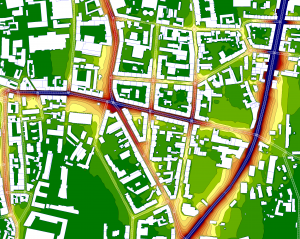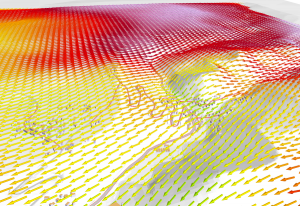News & Insights
Read the latest news from us and our clients across the globe

Posted on 20 June 2018 by Ceris Burns
Mapping out the way to better air quality
Air pollution levels globally remain above safe levels with significant impact on our health and wellbeing. Arne Berndt, owner / adviser at SoundPLAN GmbH and SoundPLAN International LLC looks how mapping software can help alleviate its worst affects.
 While the nature of air pollution may have changed over recent decades, and progress has been made to tackle it, the problem still persists across the world. Globally, traffic is now the largest single contributor to air pollution, although power plants and factories also make an important contribution. The movement of goods is essential for a viable global economy and commercial vehicles account for a significant share of traffic with freight volumes projected to have 40 per cent growth by 2050.[i] Despite modern vehicles being more environmentally friendly than earlier models, the sheer volume of them means that toxic air particles from traffic have increased dramatically and are a significant risk to health.
While the nature of air pollution may have changed over recent decades, and progress has been made to tackle it, the problem still persists across the world. Globally, traffic is now the largest single contributor to air pollution, although power plants and factories also make an important contribution. The movement of goods is essential for a viable global economy and commercial vehicles account for a significant share of traffic with freight volumes projected to have 40 per cent growth by 2050.[i] Despite modern vehicles being more environmentally friendly than earlier models, the sheer volume of them means that toxic air particles from traffic have increased dramatically and are a significant risk to health.
Going in the right direction
Governments are taking new measures to try to mitigate the worst effects of air pollution, but more can and should be done. In London, for example the T-Charge (toxity charge) has come into force, there are now traffic free zones in several European capitals including Madrid and Paris. Electric buses with air purifiers to help tackle smog have recently been introduced in Beijing.
Mapping air pollution
To combat this global health menace, many countries’ planning processes require calculations for the dispersal of air pollution, when developing new road infrastructure. Mapping software is used to bridge the gap between the science needed to understand it and engineering being planned to mitigate it. ‘Dispersal’ refers to what happens to the pollution during and after its introduction into the atmosphere. Understanding this can help people identify and control it.
Air pollution is measured at monitoring stations in a number of locations, but terrain and weather factors mean that levels can vary greatly even in small areas, making wide-scale accurate measurements difficult.
Therefore instead of relying on measurements a number of models are available to map air pollution dispersal. These range from ‘simple’ Gauss models up to complex prognostic models. The model selection depends strongly on the task and the available data.
Air pollution models are highly dependent on the meteorological situation for the dispersal calculation, requiring multiple meteorological scenarios. In order to correctly assess the pollution load for average and various percentiles, it is vital to simulate the dispersal of the pollutants for a wide variety of wind directions and scenarios. An added variant is that the air pollutants are often reactive gases which change over time under the presence of UV light.
Robust and reliable
 The results of air pollution models are often critical in planning processes and need to be robust enough to withstand the scrutiny of the court system. It is essential that they can be validated and have well-defined boundary conditions, are supported by a team of experts and used by well-trained people.
The results of air pollution models are often critical in planning processes and need to be robust enough to withstand the scrutiny of the court system. It is essential that they can be validated and have well-defined boundary conditions, are supported by a team of experts and used by well-trained people.
The management of meteorological conditions and the control of different scenarios are a constant focus for developers, and software improvements regularly mean what was impossible yesterday might be possible today. Measured meteorological data must be thoroughly assessed and modified very cautiously, especially if the reference meteorological station is outside the investigation area. Developers continually add tools to assess, complete and modify data.
Consequently, air pollution mapping software has become a powerful tool to save time and avoid nasty surprises when inspecting calculation results. Some software includes diagrams to analyse background pollution measurement and to deliver supporting arguments to why the background concentrations need to be adjusted.
If poor measurements cannot be rectified, this software helps visualise data problems and supplies good arguments for better data.
Mitigating air pollution
Ideally air pollution should be reduced and eventually all but eliminated. While progress is being made in this direction, until there are significant scientific breakthroughs and cultural changes, air pollution is here to stay for the foreseeable future. Therefore it is vitally important that we monitor, map and disperse as much air pollution as possible to lessen the impact on health.
Mapping software alone cannot resolve air quality issues; that takes a lot of political will and buy-in from the general population. However, the software can play a key role and anyone involved in air pollution monitoring or dispersal should speak to an expert to get the latest information.
http://www.soundplan.eu/english/soundplan-air-pollution/
[i] McKinsey & Co ‘Urban Commercial Transport and the Future of Mobility’ September 2017
Published in World Highways Magazine – May 2018 (page EU8)
Experts in Public Relations Services & Communications Management
Our ServicesGenuine industry specialists in cleaning and hygiene, environmental and recycling, and facilities management
Our Sectors












